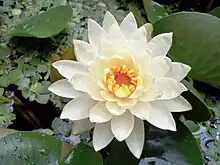Nymphaea odorata
Nymphaea odorata, also known as the American white waterlily,[2] fragrant water-lily,[3] beaver root, fragrant white water lily, white water lily, sweet-scented white water lily, and sweet-scented water lily,[4] is an aquatic plant belonging to the genus Nymphaea. It can commonly be found in shallow lakes, ponds, and permanent slow moving waters throughout North America where it ranges from Central America to northern Canada.[5][6][7][8] It is also reported from Brazil and Guyana.[9][10]

| Nymphaea odorata | |
|---|---|
 | |
| Scientific classification | |
| Kingdom: | Plantae |
| Clade: | Tracheophytes |
| Clade: | Angiosperms |
| Order: | Nymphaeales |
| Family: | Nymphaeaceae |
| Genus: | Nymphaea |
| Species: | N. odorata |
| Binomial name | |
| Nymphaea odorata Aiton | |
Description
This plant is rooted from branched rhizomes that gives rise to long petioles that terminate in smooth floating leaves. Since the leaves are subject to tearing by water and waves, they are round with a waxy upper coating that is water-repellent.[11] The flowers also float. They are radially symmetric with prominent yellow stamens and many white petals. The flowers open each day and close again each night and are very fragrant. Once the flowers are pollinated, the developing fruit is pulled back under water for maturation.[12]
Plant systematists often use it as a typical member of Nymphaeaceae, which (other than Amborella) is the most basal of the flowering plants.[13]
It is cultivated in aquatic gardens as an ornamental plant.
Cytology
The chromosome count is n = 28 or n = 56. The genome size is 1574.58 Mb.[14]
Chemistry
The lignans nymphaeoside A and icariside E, and the flavonols kaempferol 3-O-alpha-l-rhamnopyranoside (afzelin), quercetin 3-O-alpha-l-rhamnopyranoside (quercitrin), myricetin 3-O-alpha-l-rhamnopyranoside (myricitrin), quercetin 3-O-(6'-O-acetyl)-beta-d-galactopyranoside, myricetin 3-O-beta-d-galactopyranoside and myricetin 3-O-(6'-O-acetyl)-beta-d-galactopyranoside can be found in N. odorata.[15]
Subspecies
- Nymphaea odorata subsp. odorata
- Nymphaea odorata subsp. tuberosa
Uses
The fragrant water-lily has both medical and edible parts. The seeds, flowers and rhizomes can all be eaten raw or cooked.[16] The root can be boiled to produce a liquid which can be gargled to treat sore throats or drunk to treat diarrhea.[16] The rhizomes were also used by Native Americans to treat coughs and colds. The stem can be placed directly on teeth to treat a toothache.[17]
References
- Maiz-Tome, L. (2016). "Nymphaea odorata". IUCN Red List of Threatened Species. 2016: e.T64318950A67730237. doi:10.2305/IUCN.UK.2016-1.RLTS.T64318950A67730237.en. Retrieved 29 November 2022.
- USDA, NRCS (n.d.). "Nymphaea odorata". The PLANTS Database (plants.usda.gov). Greensboro, North Carolina: National Plant Data Team. Retrieved 29 January 2016.
- BSBI List 2007 (xls). Botanical Society of Britain and Ireland. Archived from the original (xls) on 2015-06-26. Retrieved 2014-10-17.
- "Lady Bird Johnson Nymphaea Odorata". Retrieved May 30, 2015.
- Stevens, W. D., C. Ulloa Ulloa, A. Pool & O. M. Montiel. 2001. Flora de Nicaragua. Monographs in systematic botany from the Missouri Botanical Garden 85: i–xlii
- CONABIO. 2009. Catálogo taxonómico de especies de México. 1. In Capital Nat. México. CONABIO, Mexico City
- Scoggan, H. J. 1978. Dicotyledoneae (Saururaceae to Violaceae). 3: 547–1115. In Flora of Canada. National Museums of Canada, Ottawa.
- Godfrey, R. K. & J. W. Wooten. 1981. Aquatic and Wetland Plants of Southeastern United States Dicotyledons 1–944. Univ. Georgia Press, Athens
- Funk, V. A., P. E. Berry, S. Alexander, T. H. Hollowell & C. L. Kelloff. 2007. Checklist of the Plants of the Guiana Shield (Venezuela: Amazonas, Bolivar, Delta Amacuro; Guyana, Surinam, French Guiana). Contributions from the United States National Herbarium 55: 1–584
- Forzza, R. C. 2010. Lista de espécies Flora do Brasil http://floradobrasil.jbrj.gov.br/2010 Archived 2015-09-06 at the Wayback Machine. Jardim Botânico do Rio de Janeiro, Rio de Janeiro
- Sculthorpe, C.D. (1967). The Biology of Aquatic Vascular Plants. Reprinted 1985 Edward Arnold, by London.
- Keddy, P.A. (2010). Wetland Ecology: Principles and Conservation (2nd edition). Cambridge University Press, Cambridge, UK. 497 p.
- Judd, W. S., C. S. Campbell, E.A. Kellogg, P. F. Stevens, and M. J. Donoghue (2002). Plant Systematics: A Phylogenetic Approach. 2nd ed. Sunderland: Sinauer.
- Chen, F., Liu, X., Yu, C., Chen, Y., Tang, H., & Zhang, L. (2017). "Water lilies as emerging models for Darwin’s abominable mystery." Horticulture research, 4.
- Zhang, Z; Elsohly, HN; Li, XC; Khan, SI; Broedel Jr, SE; Raulli, RE; Cihlar, RL; Burandt, C; Walker, LA (2003). "Phenolic compounds from Nymphaea odorata". Journal of Natural Products. 66 (4): 548–50. doi:10.1021/np020442j. PMID 12713413.
- The Complete Guide to Edible Wild Plants. United States Department of the Army. New York: Skyhorse Publishing. 2009. p. 110. ISBN 978-1-60239-692-0. OCLC 277203364.
{{cite book}}: CS1 maint: others (link) - Arnason, J. T., Hamersley Chambers, F., Karst, A., Kershaw, L., Mackinnon, A., Owen, P. 2009. Edible & medicinal plants of Canada. Edmonton, AB: Lone Pine Publishing
- Niering, William A.; Olmstead, Nancy C. (1985) [1979]. The Audubon Society Field Guide to North American Wildflowers, Eastern Region. Knopf. p. 639. ISBN 0-394-50432-1.
